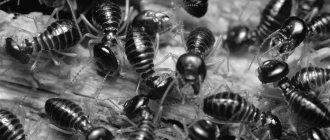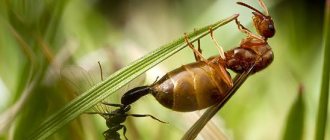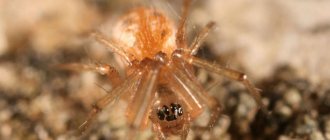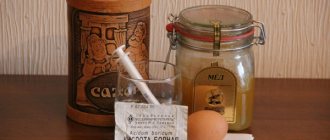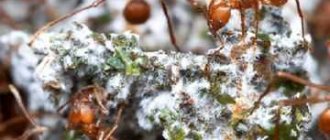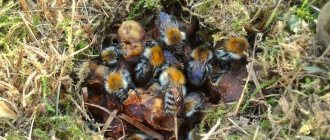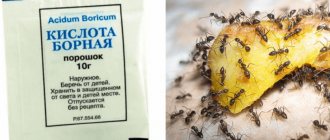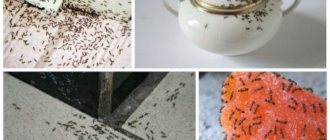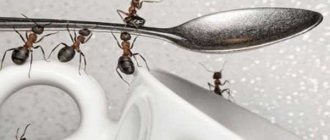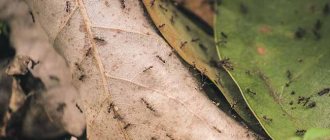| « | - Do you know, boy, that ants protect the forest from pests? Did you know that they are much smarter than humans? Do you know... In the next half hour, the stupefied Seryozha Panin learned how many species of ants exist on Earth, how they reproduce, how they fight, how they take care of their offspring and cultivate mushrooms, how they grow and graze milk aphids, how they ride in a fiery wave through the jungle, destroying all living things. , what discipline and specialization they have, what friends and enemies they are. He was especially shocked by the cunning Lomehusa beetle, which climbs into an anthill, intoxicates the inhabitants with a special liquid, and then eats the ant eggs with impunity. - Those are tattered bitches, their mother Sophia! - he condemned the bug. The image of Lomekhuza forever entered Panin’s consciousness as a symbol of the most extreme constriction. | » |
| — Mikhail Uspensky, “Paradise Machine” | ||
All for collecting lichen!
(link)
Ants and termites
- creatures of completely different origins (relatives of bees and cockroaches, respectively), but similar (in the eyes of the average person) habits. Both live in large colonies with one egg-laying queen and a crowd of constantly busy asexual[1] workers of various castes. In the mass consciousness, an ant is a small and weak creature, not much different from any other ant, but it is hardworking, persistent, and capable of working together. Usually an ant is simply the embodiment of hard work and collectivism, but if someone is compared to it, they usually emphasize its weakness and their superiority. However, in science fiction, based on ants, they can create a race very different from humans. If people somehow acquire the size of insects, the books will be in the microworld adventure genre.
Termites, on the other hand, eat wood[2]. If you ask the average person what they know about termites - and ask them not to make any reference to ants - the answer will most likely be this phrase. It is the devouring of wood by termites that has become a stereotype, forever ingrained in the brain of the average person and satirically depicted in dozens of cartoons, where these insects turn a table or stool into dust in a split second. One of the differences between termites and ants is that, in addition to the queen, termites have a king.
Krylov's fable (see below) became a tropnamer twice: Dragonfly and Ant and Dragonflies against Ants.
Ants
There are more than 12,000 species of ants. These powerful insects are capable of lifting up to 20 times their own weight. Queens can give birth to millions of babies. As social animals, they live and travel in groups.
The colonies consist of a queen, female and male workers. Some ant colonies have multiple queens. Although they cannot fly, only males and queens have wings. The male is responsible for fertilizing the ant. Only the queen lays eggs.
Solder ants act as defensive barriers, protecting the colony and guarding the queen. They attack other colonies, seeking to conquer and feed. The attackers even take the eggs of another colony and hatch them to become slaves.
Nutrition.
The main food of almost all termites is cellulose or its derivatives. Typically, termites eat dead branches and rotting parts of tree trunks, only occasionally attacking their living tissue, although there is evidence that some primitive tropical species damage tea bushes and tree stems. Representatives of the subfamily Hodotermitinae damage forage crops in Africa and Asia. A number of species feed on cereals, collecting their dry shoots in the storage chambers of their underground nests or mounded termite mounds. Some termites feed on dead leaves, and quite a few feed on the humus of tropical soils. Representatives of the subfamily Macrotermitinae breed the so-called. mushroom gardens by colonizing their excrement or plant debris with mushroom mycelium and then eating it.
Termites
Termites eat wood. The community consists of kings, queens, swarmers and workers. You differentiate swarmers and workers by the cream color of the workers. Swarmers breed where only queen ants lay eggs. Swarmers may lack wings, as the appendages may fall off shortly after birth.
Termites are detritivores, meaning they feed on wood and tree bark. Insects feed on the cellulose in wood. In some cases, they eat plants. In extreme cases, termites will also feed on plastic, paper and drywall.
These determined creatures burrow deep into wooden structures. They are usually discovered after significant damage has been caused to these structures. Having found a home, termites quickly take root. They build what are called mud pipes. These structures serve as a bridge between the food source and the colony. Mud tubes protect the colony and retain moisture. Adult termites will leave to create new colonies.
Features of behavior of young animals
The young generation lives in the termite mound of the “parents” until a certain time and leaves the “father’s house” during the swarming period (late spring - early summer), beginning to mate. At this time, they become extremely vulnerable, because after fertilization, the male and female cut off their wings. Many of the young termites are easy prey for spiders, millipedes, and insectivorous birds. The lucky survivors begin to create a nest. Not everyone leaves the termite mound: several pairs remain in case of possible death of the female, which happens quite rarely.
Comparison of Ants and Termites
The following table compares the two, highlighting at a glance the main differences between them.
| Ants | Termites | |
| Ants are social animals, members of the family Formicidae. Surprisingly, they are related to bees and wasps. | Termites are social animals. Part of the family Rhinotermitidae, termites' closest relatives are cockroaches. | |
| Appearance | Like all insects, ants have three pairs of legs. Each leg has three joints. They have large, curved antennae, powerful jaws, and compound eyes. They come in black or red. | Termites have a soft body with straight antennae. Colors range from light brown to white. Termite swarms are dark, but worker termites appear lighter in color. |
| Colonies | The ant community consists of queens, females and males. Each group has its own specific responsibilities. | The termite community is more defined by a caste system. You have workers, soldiers and termite infestations. |
| Wings | Ants have many large front and rear wings. | Termites have four equally sized wings. |
| Diets | Ants' diets vary depending on the species. They mainly feed on seeds, leaves, small insects, honeydew and nectar. Ants collect food and carry it to the colony. | Termites eat wood because cellulose is critical to survival. But this causes significant damage as they burrow into destroyed foundations. |
| Behavior | Ants travel in well-organized, almost militant groups. They are looking for food to take home. Outdoors, you will see ants congregating outside their mounds or boldly running into them. Ants find food with an uncanny sense of smell. It is no coincidence that they invade picnics. | Termites are actually rarely seen as they tend to spend their time safely in mud tubes and in their feeding areas. You have a better chance of being the first to encounter the damage left behind by them. |
Together - we are force
There is nothing strange in the custom of spiders and female praying mantises to eat their suitors. It's just that most predatory insects recognize only two classes of objects. “Small and moving” - food. “Big and moving” is the enemy. The male is smaller. He is food
The benefits of cooperation are undeniable. But to unite the forces of many individuals, altruism is required, the willingness to sacrifice the personal for the sake of the common. This amazing impulse is based on the instinct of procreation. And in the simplest case, it prohibits eating one’s own offspring. It should be noted that, for example, most predatory fish, even viviparous ones, do not have any complexes in this regard. The baby, as soon as it is born, is immediately forced to flee from its mother. For the first time, the ability, in addition to “enemies” and “prey,” to recognize a third category of objects—“friends”—appeared about 200 million years ago. Probably, it is precisely in insects, which rapidly form new species, and therefore are quick to come up with inventions.
From tolerance to your own offspring there is only one tiny step to caring for them. If young individuals do not need to flee from adults, nothing prevents them from staying nearby, automatically receiving some protection (what is an “enemy” for them is “prey” for the mother) and even food - in the form of scraps from the table of their elders.
The next step towards the formation of a “superorganism” may be the cohabitation of several generations of already mature individuals. However, this step is rarely taken, because crowding only means competition for food. It’s another matter if the creatures decide to search for and capture prey with their combined forces. But to do this, you first need to invent some way of exchanging information.
The chemical signals of ants living in huge families are extremely complex and varied, but the main one is the most obvious. As soon as one ant uses a weapon, others immediately rush to the smell of formic acid. And even if the “sentinel” encountered a creature that falls under the definition of “enemy,” there is a high probability that the enemy himself will become prey when the rest of the ants come running.
Ants are the absolute record holders among invertebrates in terms of the ratio of brain to body mass. Complex joint actions require developed intelligence
But on the way to a social lifestyle there is another obstacle - genetics. If the offspring, growing up, remain in the same nest, inbreeding is inevitable. Therefore, it is possible to further build an ideal state in a single rotten stump only if the older female secretes a special pheromone - a volatile substance that suppresses sexual desire in other inhabitants of the nest. This is how the bumblebee community works, for example. All females in a nest are identical and have the potential to reproduce, but only one lays eggs. If the queen dies, the release of the asexual pheromone will stop, and another female will become fertile.
The bumblebee approach to the problem is reliable, like everything primitive, but it is not without its drawbacks. One ordinary female cannot make up for the losses of a family if there are more than several dozen individuals. The path to prosperity and, in fact, to world domination of social insects is opened only by physical specialization - division into castes. Winged individuals are needed for dispersal, exchanging genes and founding nests, where they then turn into stationary egg factories.
Secrets of the anthill
Termite mounds and anthills are extremely complex structures. It is difficult to imagine how tiny insects, without a unified plan and general guidance, can build them. This allows parascience to freely use the homes of social insects as evidence of the existence of telepathy, information fields and the “collective mind” dear to the hearts of science fiction writers. However, the plan is not transmitted to the ants from somewhere outside - it really does not exist.
In nature, you will not find two identical termite mounds or anthills. The location of passages and chambers in each is unique. Because the organization of work is extremely simple. The ants operating outside the heap build it up, tirelessly burying their brethren remaining inside. They, in turn, dig out, clearing passages to the surface. Chambers for mushroom plantations, eggs and larvae are created as needed in the depths of the heap by expanding the corridors.
Termites act in the same way - with the only difference that their fortress is built from the inside. The outer layer of the structure is riddled with random “technical” passages. The main corridors, ventilation shafts and halls are not planned in advance, but are hollowed out in the thickness of the termite mound when and where needed.
By the way, if the bustle of ants and termites seems chaotic and stupid to you, you are absolutely right. Insects waste approximately 80% of their effort by interfering with each other or building something that will immediately be dismantled.
6 Key Differences Between Termites and Ants
Ants and termites often count against each other, although termites are never outdoors. Here are six main differences between termites and ants.
Termites vs Ants: Antennas
The ant is the only insect to have bent antennae. Termites have normal straight antennae, but they look like they have balls or beads on them.
Termites vs Ants: Body Shapes
Ants have a narrow body, especially around the middle or waist. Termites tend to have wider waists.
Termites vs Ants: Wings
Both termites and ants have four wings. Termite wings are fairly uniform in size. Ants have two small wings on their hind legs. The front wings are larger. Both insects may lose their wings. Exterminators say homeowners are more likely to discover discarded termite wings before seeing the insects themselves.
Termites vs Ants: Visibility
The ant settles in various conditions as it feeds for food. This is why you will see ants boldly walking around your indoor and outdoor spaces. Most often they are found on baseboards and window sills. Subterranean termites. You will find evidence of their work, such as droppings and wings, but you will rarely see termites.
Termites vs ants: diets
Ants eat a variety of foods, including other insects. Termites adhere strictly to a arboreal diet. But they don't eat wood. Instead, the insects feed on the cellulose in the wood. They shave the tree and extract the compound.
II
These questions are still not fully resolved, and the most rigorous observations often contradict each other. Thus, we see that bees miraculously overcome the age-old routine. For example, they immediately realized how useful they could be from the artificial honeycombs that humans provided them with. These lightly marked combs literally turn their working methods on their head and allow them to build in a few days what would normally require weeks of worry and a huge expenditure of honey. We note also that when they are transported to Australia or California, in the second or third year they notice that the summer here is perpetual and there is never a lack of flowers, and they live one day at a time, collecting only the honey and pollen necessary for their daily consumption; their new, rational observations take precedence over their ancestral experience, and they no longer store for the winter; and in the Barbados refinery, where they find sugar in abundance all year round, the bees stop collecting nectar altogether.
But, on the other hand, who among us, watching ants at work, was not amazed at the meaninglessness of their joint efforts? Ten of them pull in different directions the prey, which two of them, if they understood each other, could easily carry to the nest. The harvester ant (Messor barbarus), according to the observations of myrmecologists V. Cornet and Ducelier, provides even more striking and characteristic examples of inconsistency and stupidity. While several workers sitting on the spikelet are cutting off the glume at the base, in which the wheat grains are wrapped, a large worker ant is cutting the stem a little below the spikelet, not realizing that it is doing completely unnecessary, long and hard work.
These same “reapers” put much more grains into their nest than necessary; during the rainy season they sprout, and the emerging shoots of wheat indicate the location of the anthill to the farmers, who hastily destroy it. This fatal phenomenon has been repeated for centuries, but experience has not changed the habits of Messor barbarus and has not taught it anything.
Mirmecocystus cataglyphis bicolor, or the red phaeton, another North African ant, has very long legs, allowing it to go out into the sun and not be afraid of being burned by the soil, the temperature of which exceeds forty degrees, while other insects, with not so long legs, die. He rushes forward at an insane speed, reaching twelve meters per minute (everything in this world is relative), despite the fact that his eyes cannot see further than five six centimeters and do not notice anything in the whirlwind of this run. He flies over the pieces of sugar, which he loves very much, without noticing them at all, and returns home, bringing nothing back from his long and crazy trips. For millions of years, millions of ants of this species resume this heroic and ridiculous quest every summer, without yet realizing their futility.
Is an ant really dumber than a bee? The facts known to us do not allow us to say so. Do we accept the simple reflexes of our “honey flies” as intelligence, or do we poorly understand ants and all our explanations are just phantasms of our imagination? Isn't Anima Mundi wrong more often than we dare to imagine? Can insects be blamed for their mistakes? What about ours? All I know is that one of nature's most vexing mysteries is the obvious mistakes and irrational actions we encounter. From this we can conclude that she has talent, but not common sense, and that she is not always smart. But by what right, from the height of our little brain - this “mold” on nature itself, do we consider these actions irrational? If we were ever to discover the rational in nature, it might crush our tiny minds. We judge everything from the height of our arrogant logic, convinced that there cannot be another that would contradict the one that serves as our only guide. But it is not at all reliable. Perhaps this is just an optical illusion in the vast expanses of infinity. Perhaps nature has made mistakes more than once, but before we publicly declare this, let us not forget that we are still in ignorance and darkness, the idea of which we could only imagine in another world.
Moving up
5. Some build colonies upward, creating building-like mud mounds. In tropical areas such as Africa, mounds can become very large. They build mud tubes to reach the tree they eat, the tubes are usually located outside.
But can be built inside. One pipe found stretched 3.5 meters from the floor to the ceiling of the house, swaying in the wind caused by the air conditioner.
A 12-meter-high hill was discovered in Africa - about the size of a two-story house.
6. Causes over $5 billion in property damage each year.
7. Like ants, they are “social”, creating caste systems where everyone plays a different role. Only workers destroy wood.
8. The soldier and reproductive castes cannot feed themselves. They rely on workers to feed them disintegrated cellulose spewed from their mouths.
Learn more How to get rid of fruit flies
Regulation of caste composition.
Apparently, the number of individuals of different types is regulated in a certain way. The reproductive caste is necessary primarily for the founding of new colonies and the laying of eggs. Typically, all individuals of a colony, which can contain up to 3 million insects of different castes and stages of development, are the offspring of one king and one queen. Winged individuals of two sexes appear in a certain season for the dispersal summer. In primitive termites, queens are relatively small, and their ovaries are only slightly enlarged compared to their body size, but in more evolutionarily advanced taxa, the abdomen of females that have begun to reproduce is huge and literally filled with eggs. The length of queens of tropical species is 2–10 cm, and they lay up to 8,000 eggs per day. In evolutionarily advanced species, the adult population consists mainly of workers, and only 1–15% of individuals become soldiers.
In experimental colonies, the removal of one or both reproductive individuals usually results in the development of "replacement" nymphs - without wings or with only their rudiments. Removing soldiers also stimulates the transformation of undifferentiated nymphs into them. The regulation of the caste composition of the colony is explained by the so-called. "the theory of inhibition". It is assumed that reproductive individuals and soldiers secrete some kind of inhibitory substance (telergon), which is licked off by their relatives. The exchange of telergons between them (“mutual feeding” or trophallaxis), reaching the nymphs, suppresses the development of the latter into the corresponding castes. With the experimental removal of soldiers or breeders (or the aging of the royal couple), the number of telergons does not reach a threshold level, and the nymphs turn into those whose inhibitory substances are currently in short supply.
